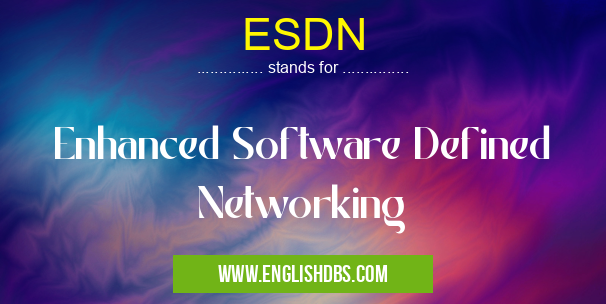What does ESDN mean in NETWORKING
Enhanced Software Defined Networking (ESDN) is an advanced form of Software Defined Networking (SDN) that provides enhanced capabilities and flexibility for network management and orchestration. SDN is a networking paradigm that separates the control plane, which manages network behavior, from the data plane, which handles the actual data forwarding. ESDN takes SDN to the next level by introducing additional features and functionalities that enable more efficient and dynamic network management.

ESDN meaning in Networking in Computing
ESDN mostly used in an acronym Networking in Category Computing that means Enhanced Software Defined Networking
Shorthand: ESDN,
Full Form: Enhanced Software Defined Networking
For more information of "Enhanced Software Defined Networking", see the section below.
» Computing » Networking
Key Features of ESDN
- Centralized Control: ESDN provides a centralized control plane that allows for the management and configuration of the entire network from a single point. This simplifies network administration and enables rapid changes and updates to be made across the network.
- Policy-Based Management: ESDN enables the definition and enforcement of network policies that govern how traffic is routed and managed. These policies can be applied across the entire network or to specific devices and applications, providing greater control and flexibility.
- Network Virtualization: ESDN supports network virtualization, allowing multiple logical networks to be created and managed on top of a single physical network infrastructure. This enables the creation of isolated and secure network environments for different applications and services.
- Automation and Orchestration: ESDN incorporates automation and orchestration tools that streamline network management tasks. These tools can automate the provisioning, configuration, and monitoring of network resources, reducing operational costs and improving efficiency.
- Openness and Extensibility: ESDN is built on open standards and APIs, allowing for integration with third-party applications and services. This openness promotes innovation and enables the development of customized network solutions.
Benefits of ESDN
- Improved Network Agility: ESDN enables rapid network changes and updates, allowing organizations to quickly adapt to changing business requirements and technological advancements.
- Increased Network Visibility and Control: The centralized control plane provides a comprehensive view of the entire network, allowing for better monitoring and troubleshooting.
- Enhanced Security: ESDN supports the implementation of advanced security policies and mechanisms, protecting the network from threats and vulnerabilities.
- Reduced Operational Costs: Automation and orchestration tools reduce the manual effort required for network management, leading to lower operating expenses.
- Innovation and Customization: ESDN's openness and extensibility enable organizations to develop customized network solutions that meet their specific needs and requirements.
Essential Questions and Answers on Enhanced Software Defined Networking in "COMPUTING»NETWORKING"
What is Enhanced Software Defined Networking (ESDN)?
ESDN is an advanced form of Software Defined Networking (SDN) that extends the capabilities of traditional SDN to provide greater flexibility, control, and programmability in network management. It enables network administrators to dynamically configure, manage, and optimize network resources based on specific requirements.
What are the key benefits of ESDN?
ESDN offers numerous benefits, including:
- Increased network flexibility and agility
- Improved network performance and efficiency
- Enhanced network security and visibility
- Reduced operating costs and increased efficiency
- Simplified network management and automation
How is ESDN different from traditional SDN?
ESDN builds upon the foundation of traditional SDN but incorporates additional features and capabilities, such as:
- Advanced traffic management and routing capabilities
- Support for network virtualization and segmentation
- Integration with artificial intelligence (AI) and machine learning (ML)
- Extended programmability and automation
What are the applications of ESDN?
ESDN finds applications in various scenarios, including:
- Data center and cloud networking
- Enterprise and campus networks
- Service provider and carrier networks
- IoT and edge computing environments
How is ESDN implemented?
ESDN is typically implemented using a software-based controller that separates the control plane from the data plane. The controller centralizes network management and allows administrators to program network behavior through APIs or graphical user interfaces.
Final Words: ESDN is a powerful and comprehensive networking solution that provides organizations with enhanced network management capabilities, flexibility, and control. Its features such as centralized control, policy-based management, network virtualization, automation, and openness enable organizations to optimize their networks for performance, security, and efficiency. As the demand for agile, secure, and scalable networks continues to grow, ESDN is poised to play a critical role in the future of networking.
